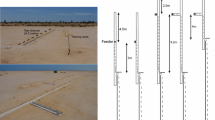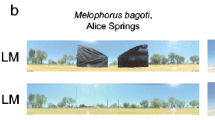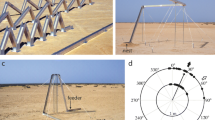Abstract
Desert ants that forage solitarily continually update their position relative to the nest through path integration. This is accomplished by combining information from their celestial compass and pedometer. The path integration system can adapt when memories of previous inbound routes do not coincide with the outbound route, through vector calibration. Here, we test the speed and limit of vector calibration in the desert ant Melophorus bagoti by creating directional conflicts between the inbound and outbound routes (45°, 90°, 135°, 180°). The homeward vector appears to calibrate rapidly after training with shifts occurring after three foraging trips, yet the limit of the vector’s plasticity appears to be a maximum of 45°. At 45° conflicts, the vector calibrates the full 45°, suggesting dominance of the previous inbound memories over the outbound cues of the current trip. Yet at larger directional conflicts, vector shifts after training diminish, with foragers in the 90° and 135° conditions showing smaller intermediate shifts between the inbound memories and the current outbound vector. When the conflict is at its maximum (180°), foragers show no calibration, suggesting the outbound vector is dominant. Panorama exposure during training appears to aid foragers orienting to the true nest, but this also appears limited to about a 45° shift and does not improve with training.






Similar content being viewed by others
References
Batschelet E (1981) Circular Statistics in Biology. New York: Academic Press
Bregy P, Sommer S, Wehner R (2008) Nest-mark orientation versus vector navigation in desert ants. J Exp Biol 211:1868–1873
Bühlmann C, Cheng K, Wehner R (2011) Vector-based and landmark-guided navigation in desert ants inhabiting landmark-free and landmark-rich environments. J Exp Biol 214:2845–2853
Buehlmann C, Graham P, Hansson BS, Knaden M (2015) Desert ants use olfactory scenes for navigation. Anim Behav 106:99–105
Cheng K, Freas CA (2015) Path integration, views, search, and matched filters: the contributions of Rüdiger Wehner to the study of orientation and navigation. J Comp Physiol A 201(6):517–532
Cheng K, Narendra A, Sommer S, Wehner R (2009) Traveling in clutter: navigation in the central Australian ant Melophorus bagoti. Behav Process 80:261–268
Cheng K, Schultheiss P, Schwarz S, Wystrach A, Wehner R (2014) Beginnings of a synthetic approach to desert ant navigation. Behav Processes 102:51–61
Christian KA, Morton SR (1992) Extreme thermophilia in a Central Australian ant, Melophorus bagoti. Physiol Zool 65:885–905
Collett TS (1992) Landmark learning and guidance in insects. Philos Trans R Soc Lond B Biol Sci 337:295–303. https://doi.org/10.1098/rstb.1992.0107
Collett M, Collett TS (2000a) How do insects use path integration for their navigation? Biol Cyber 83(3):245–259
Collett TS, Collett M (2000b) Path integration in insects. Curr Opin Neurobiol 10:757–762
Collett M, Collett TS, Wehner R (1999) Calibration of vector navigation in desert ants. Curr Biol 9:1031–1034
Etienne AS, Teroni V, Hurni C, Portenier V (1990) The effect of a single light cue on homing behaviour of the golden hamster. Anim Behav 39:17–41
Etienne AS, Maurer R, Seguinot V (1996) Path intergration in mammals and its interaction with visual landmarks. J Exp Biol 199:201–209
Fent K (1986) Polarised skylight orientation in the desert ant Cataglyphis. J Comp Physiol A 158:145–150
Freas CA, Cheng K (2017) Learning and time-dependent cue choice in the desert ant Melophorus bagoti. Ethology 123:503–515. https://doi.org/10.1111/eth.12626
Freas CA, Whyte C, Cheng K (2017a) Skyline retention and retroactive interference in the navigating Australian desert ant, Melophorus bagoti. J Comp Physiol A 203:353. https://doi.org/10.1007/s00359-017-1174-8
Freas CA, Narendra A, Cheng K (2017b) Compass cues used by a nocturnal bull ant, Myrmecia midas. J Exp Biol 220:1578–1585. https://doi.org/10.1242/jeb.152967
Freas CA, Narendra A, Lemesle C, Cheng K (2017c) Polarized light use in the nocturnal bull ant, Myrmecia midas. R Soc Open Sci 4(8):170598
Graham P, Cheng K (2009) Which portion of the natural panorama is used for view-based navigation in the Australian desert ant? J Comp Physiol A 195:681–689
Holm S (1979) A simple sequential rejective method procedure. Scand J Stat 6:65–70
Kohler M, Wehner R (2005) Idiosyncratic route memories in desert ants, Melophorus bagoti: How do they interact with path-integration vectors? Neurobiol Learn Mem 83:1–12
Labhart T, Meyer EP (1999) Detectors for polarized skylight in insects: a survey of ommatidial specializations in the dorsal rim area of the compound eye. Microsc Res Tech 47:368–379
Legge ELG, Wystrach A, Spetch ML, Cheng K (2014) Combining sky and Earth: desert ants (Melophorus bagoti) show weighted integration of celestial and terrestrial cues. J Exp Biol 217:4159–4166
Mangan M, Webb B (2012) Spontaneous formation of multiple routes in individual desert ants (Cataglyphis velox). Behav Ecol 23:944–954. https://doi.org/10.1093/beheco/ars051
Mittelstaedt H (1983) The role of multimodal convergence in homing by path integration. Fortschr Zool 28:197–212
Müller M, Wehner R (1994) The hidden spiral: systematic search and path integration in desert ants, Cataglyphis fortis. J Comp Phys A 175:525–530
Muser B, Sommer S, Wolf H, Wehner R (2005) Foraging ecology of the thermophilic Australian desert ant, Melophorus bagoti. Aust J Zool 53:301–311
Narendra A (2007) Homing strategies of the Australian desert ant Melophorus bagoti II. Interaction of the path integrator with visual cue information. J Exp Biol 210:1804–1812
Narendra A, Cheng K, Wehner R (2007a) Acquiring, retaining and integrating memories of the outbound distance in the Australian desert ant Melophorus bagoti. J Exp Biol 210:570–577
Narendra A, Si A, Sulikowski D, Cheng K (2007b) Learning, retention and coding of nest-associated visual cues by the Australian desert ant, Melophorus bagoti. Behav Ecol Sociobiol 61:1543–1553
Narendra A, Gourmaud S, Zeil J (2013a) Mapping the navigational knowledge of individually foraging ants, Myrmecia croslandi. Proc R Soc B 280:20130683
Narendra A, Reid SF, Raderschall CA (2013b) Navigational efficiency of nocturnal Myrmecia ants suffers at low light levels. PLoS One 8:e58801
Narendra A, Ramirez-Esquivel F, Ribi WA (2016) Compound eye and ocellar structure for walking and flying modes of locomotion in the Australian ant, Camponotus consobrinus. Sci Rep 6:22331
Otto F (1959) Die Bedeutung des Rückfluges für die Richtings – und Entfernungsangabe der Bienen. Z Vergl Physiol 42:303–333
Schultheiss P, Cheng K (2011) Finding the nest: inbound searching behaviour in the Australian desert ant, Melophorus bagoti. Anim Behav 81:1031–1038
Schultheiss P, Wystrach A, Scwarz S, Tack A, Delor J, Nooten SS, Bibost AL, Freas CA, Cheng K (2016) Crucial role of ultraviolet light for desert ants in determining direction from the terrestrial panorama. Anim Behav 115:19–28
Schwarz S, Cheng K (2010) Visual associative learning in two desert ant species. Behav Ecol Sociobiol 64:2033–2041
Wehner R (1987) Spatial organization of the foraging behavior in individually searching desert ants, Cataglyphis (Sahara desert) and Ocymyrmex (Namib desert). In: Pasteels JM, Deneubourg JM (eds) From individual to collective behavior in insects. Birkhäuser, Basel, pp 15–42
Wehner R (1994) The polarization-vision project: championing organismic biology. In: Schildberger K, Elsner N (eds) Neural basis of behavioural adaptation. Fischer, Stuttgart, pp 103–143
Wehner R (2003) Desert ant navigation: how miniature brains solve complex tasks. J Comp Physiol A 189:579–588
Wehner R (2008) The architecture of the desert ant’s navigational toolkit (Hymenoptera: Formicidae). Myrmecol News 12:85–96
Wehner R, Müller M (2006) The significance of direct sunlight and polarized skylight in the ant’s celestial system of navigation. Proc Natl Acad Sci USA 103:12575–12579
Wehner R, Räber F (1979) Visual spatial memory in desert ants, Cataglyphis bicolor (Hymenoptera: Formicidae). Experientia 35:1569–1571
Wehner R, Srinivasan MV (1981) Searching behaviour of desert ants, genus Cataglyphis (Formicidae, Hymenoptera). J Comp Physiol A 142:315–338
Wehner R, Wehner S (1986) Path integration in desert ants. Approaching a long-standing puzzle in insect navigation. Monit Zool Ital 20:309–331
Wehner R, Michel B, Antonsen P (1996) Visual navigation in insects: coupling of egocentric and geocentric information. J Exp Biol 199:129–140
Wehner R, Gallizzi K, Frei C, Vesely M (2002) Calibration processes in desert ant navigation: vector courses and systematic search. J Comp Physiol A 188:683–693
Wehner R, Boyer M, Loertscher F, Sommer S, Menzi U (2006) Ant navigation: one-way routes rather than maps. Curr Biol 16:75–79
Wittlinger M, Wehner R, Wolf H (2007) The desert ant odometer: a stride integrator that accounts for stride length and walking speed. J Exp Biol 210:198–207
Wystrach A, Schwarz S, Schultheiss P, Baniel A, Cheng K (2014) Multiple sources of celestial compass information in the central Australian desert ant Melophorus bagoti. J Comp Physiol A 200:1–11
Zar JH (1998) Biostatisical analysis, 4th edn. Engelwood Cliffs, New Jersey
Zeil J, Ribi WA, Narendra A (2014) Polarization vision in ants, bees and wasps. In: Horváth G (ed) Polarized light and polarization vision in animal sciences, 2nd edn. Springer, Berlin, pp 41–60
Acknowledgements
This research was supported by a Grant from the Australian Research Council (DP150101172) and many thanks to the Centre of Appropriate Technology for access to the field site and nests. The authors declare no conflict of interests in association with this work.
Author information
Authors and Affiliations
Contributions
Experiments conceived and designed: CAF. Data collection and analysis: CAF. Manuscript production and revision: CAF and KC.
Corresponding author
Electronic supplementary material
Below is the link to the electronic supplementary material.
Rights and permissions
About this article
Cite this article
Freas, C.A., Cheng, K. Limits of vector calibration in the Australian desert ant, Melophorus bagoti . Insect. Soc. 65, 141–152 (2018). https://doi.org/10.1007/s00040-017-0595-2
Received:
Revised:
Accepted:
Published:
Issue Date:
DOI: https://doi.org/10.1007/s00040-017-0595-2




